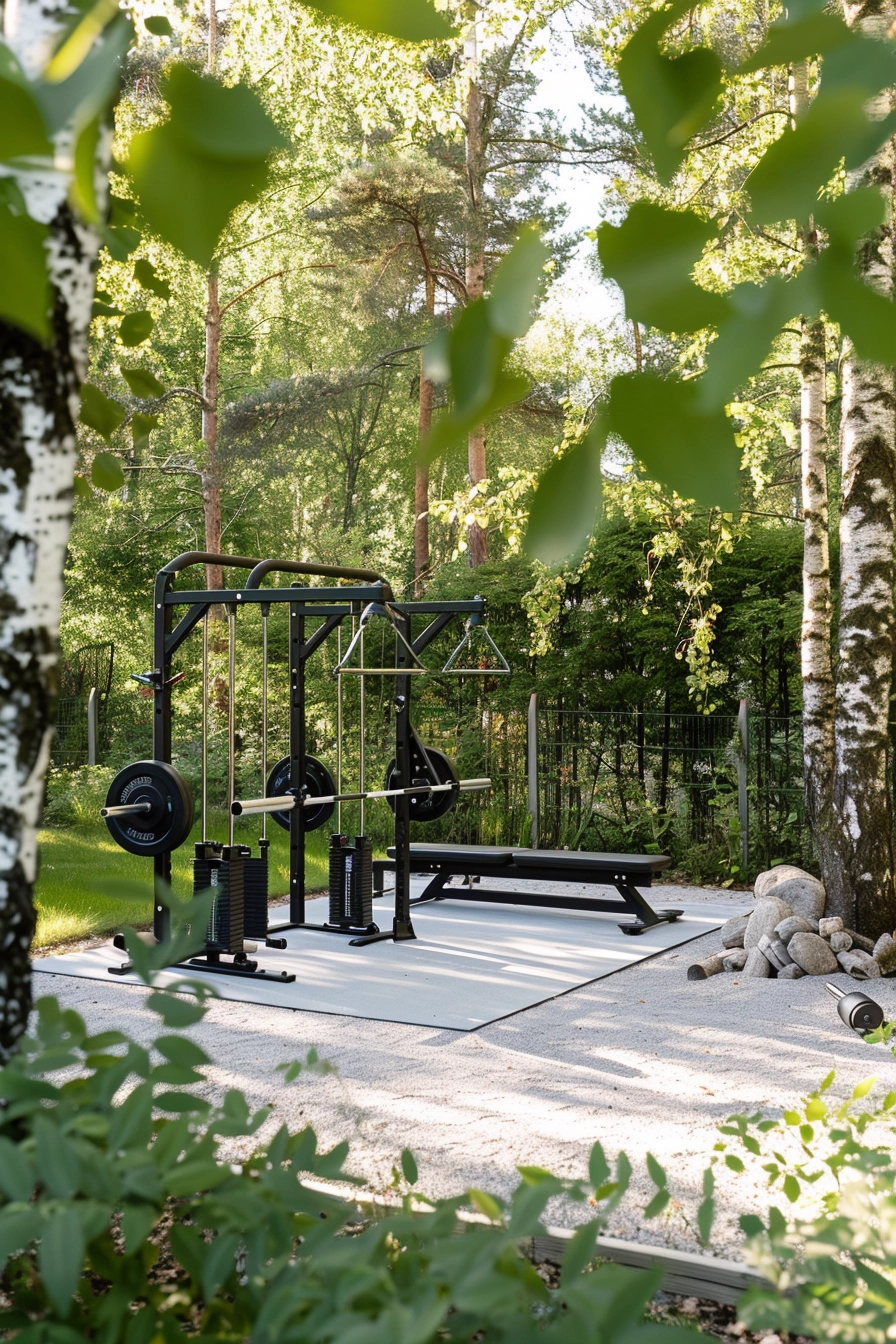Building an outdoor gym in your backyard can enhance your fitness routine and provide a dedicated space for enjoyable and effective outdoor workouts. Whether you prefer a simple setup with basic equipment or a fully-equipped fitness area, designing your own backyard gym is an exciting project that allows you to tailor it to your specific needs and preferences.
When planning and building your backyard fitness area, there are several factors to consider. To ensure a comfortable workout experience, think about suitable garden shelter options, whether you want a temporary or permanent setup, weather-proof gym equipment, insulation and air-conditioning, suitable outdoor flooring, durable and low maintenance materials, lighting for your workout space, and noise level-reducing gym flooring.
Key Takeaways
- Creating a backyard gym allows for enjoyable and effective outdoor workouts.
- Consider factors like suitable garden shelter, temporary or permanent setup, and weather-proof gym equipment when planning your backyard fitness area.
- Choose durable and low maintenance materials and install noise-reducing gym flooring for a comfortable workout space.
- Take advantage of natural lighting and consider using artificial lighting for evening workouts.
- Optimize your workout area with insulation and air-conditioning for year-round use.
Things to Consider Before Building Your Backyard Gym
When it comes to creating a home workout area in your backyard, there are several factors to consider for a successful and enjoyable outdoor gym setup. From the layout of your backyard workout space to the choice of equipment and materials, careful planning can help you design a functional and aesthetically pleasing fitness area.
1. Suitable Garden Shelter
Before you start building your backyard gym, think about the available garden shelter options. Do you prefer an open-air setup or a covered space? Consider the weather conditions in your area and how the shelter will protect you and your equipment from rain, excessive sunlight, or other elements.
2. Temporary or Permanent Setup
Decide whether you want a temporary or permanent gym setup in your backyard. A temporary setup allows for flexibility and easy relocation, while a permanent structure provides stability and a designated fitness area. Consider your preferences and long-term plans before making a decision.
3. Weather-proof Gym Equipment
Investing in weather-proof gym equipment is essential for the longevity and functionality of your outdoor gym. Look for exercise equipment made from durable materials that can withstand exposure to the elements, such as stainless steel or heavy-duty plastic.

4. Insulation and Air-conditioning
Depending on your location and climate, you may need to consider insulation and air-conditioning options for your backyard gym. Proper insulation can help regulate temperature and reduce energy costs, while air-conditioning can provide a comfortable workout environment during hot summer days.
5. Suitable Outdoor Flooring
Choose suitable outdoor flooring for your backyard workout space. Opt for materials that are durable, low maintenance, and slip-resistant. Rubber flooring or interlocking tiles are popular choices that provide cushioning and protection against impact.
6. Layout and Equipment Needs
Think about the layout of your backyard gym and how it will cater to your fitness goals and equipment needs. Consider the space required for each exercise, ease of movement, and accessibility to different areas of the gym. This will help ensure a smooth and efficient workout experience.
7. Noise Reduction
Consider the noise level of your gym and its potential impact on your family and neighbors. Opt for noise-reducing gym flooring, such as rubber mats or specialized sound-dampening materials, to minimize disruption. Additionally, strategic placement of equipment and insulation can help reduce noise transmission.
By taking these factors into account, you can create a backyard workout space that is tailored to your needs, maximizes functionality, and enhances your fitness journey. With the right planning and attention to detail, your outdoor gym will become the perfect setting for achieving your fitness goals.

Tips for Designing an Outdoor Gym on a Budget
Creating a home workout area doesn’t have to break the bank. With a little creativity and resourcefulness, you can design a DIY outdoor exercise space that fits your budget and fitness goals.
One cost-effective strategy is to repurpose existing equipment. Look for used workout equipment on platforms like Facebook Marketplace or in secondhand sports stores. Not only will this save you money, but it also encourages sustainable consumption by giving these items a new lease on life.
Another budget-friendly tip is to maximize space with small storage solutions. Install shelves and hooks to keep your gym organized and tidy. This will not only help you find your equipment easily but also create a visually appealing and functional workout area.
When it comes to adding interest to your outdoor gym, think outside the box. Consider inexpensive options like stenciling or hanging posters on the walls. These simple touches can transform your workout space into a motivating environment that enhances your fitness experience.
To protect your joints during outdoor workouts, invest in rubber floor mats. You don’t need to splurge on expensive gym flooring. Rather, look for affordable options like horse stall mats from farm supply stores. These mats provide cushioning and support while being gentle on your budget.
Lastly, start small and gradually build up your backyard gym as your budget allows. Begin with a few essential pieces of equipment like resistance bands, jump ropes, and good running shoes. As you progress, you can add more outdoor fitness equipment to diversify your workouts and continue challenging yourself.


